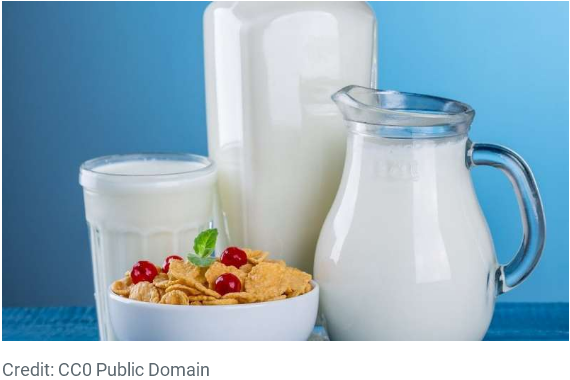2020-01-08 20:28
孩子喝何种奶更健康?
诸平

据加拿大圣迈克尔医院(St. Michael's Hospital)2019年12月30日提供的消息,最新研究发现:喝全脂牛奶的儿童超重或肥胖的风险较低。
多伦多团结健康圣迈克尔医院(St. Michael's Hospital of Unity Health Toronto)领导的系统评价和荟萃分析发现,喝全脂牛奶的孩子与食用低脂牛奶的孩子相比,超重或肥胖的几率降低了40%。该研究于2019年12月18日已发表在《美国临床营养杂志》(American Journal of Clinical Nutrition)——Shelley M Vanderhout, Mary Aglipay, Nazi Torabi, Peter Jüni, Bruno R da Costa, Catherine S Birken, Deborah L O'Connor, Kevin E Thorpe, Jonathon L Maguire. Whole milk compared with reduced-fat milk and childhood overweight: a systematic review and meta-analysis, The American Journal of Clinical Nutrition, 2019, nqz276. Published: 18 December 2019.DOI: 10.1093/ajcn/nqz276. https://doi.org/10.1093/ajcn/nqz276
此分析了来自7个国家的28项研究,葡京赌博网站,探讨了喝牛奶的孩子与超重或肥胖风险之间的关系。没有一项研究(涉及近2.1万名1~18岁的儿童)表明,喝低脂牛奶的孩子超重或肥胖的风险较低。在28项研究中,有18项表明喝全脂牛奶的儿童超重或肥胖的可能性较小。
该发现对加拿大和国际准则提出了挑战,该准则建议儿童从2岁开始食用低脂牛奶而不是全脂牛奶,以降低肥胖的风险。
该研究的主要作者,圣迈克尔医院的儿科医生乔纳森·马奎尔(Jonathon Maguire)博士说:“加拿大和美国的大多数儿童每天都喝牛奶,牛奶是许多儿童饮食中脂肪的主要来源。”“在我们的研究中,遵循目前建议在两岁时改用低脂牛奶的孩子并不比那些消费全脂牛奶的孩子瘦。”
乔纳森·马奎尔博士还是MAP城市健康解决方案中心的科学家,他希望通过一项随机对照试验确定全脂牛奶和降低肥胖风险的因果关系。
乔纳森·马奎尔博士说:“我们检查的所有研究都是观察性研究,葡京赌博官网,葡京赌博官网,这意味着我们无法确定全脂牛奶是否会降低超重或肥胖的风险。全脂牛奶可能与降低超重或肥胖风险的其他因素有关。”“一项随机对照试验将有助于确定因果关系,葡京赌博网站 葡京赌博网址,但文献中没有发现。”
更多信息请注意浏览原文或者相关报道。
Whole-fat milk consumption associated with leaner children, research finds
Whole-fat milk consumption associated with leaner children, research finds
ABSTRACT
Background
The majority of children in North America consume cow-milk daily. Children aged >2 y are recommended to consume reduced-fat (0.1%–2%) cow-milk to lower the risk of obesity.
Objectives
To evaluate the relation between cow-milk fat consumption and adiposity in children aged 1–18 y.
Methods
Embase (Excerpta Medica Database), CINAHL (Cumulative Index to Nursing and Allied Health Literature), MEDLINE, Scopus, and Cochrane Library databases from inception to August 2019 were used. The search included observational and interventional studies of healthy children aged 1–18 y that described the association between cow-milk fat consumption and adiposity. Two reviewers extracted data, using the Newcastle–Ottawa Scale to assess risk of bias. Meta-analysis was conducted using random effects to evaluate the relation between cow-milk fat and risk of overweight or obesity. Adiposity was assessed using BMI z-score (zBMI).
Results
Of 5862 reports identified by the search, 28 met the inclusion criteria: 20 were cross-sectional and 8 were prospective cohort. No clinical trials were identified. In 18 studies, higher cow-milk fat consumption was associated with lower child adiposity, and 10 studies did not identify an association. Meta-analysis included 14 of the 28 studies (n = 20,897) that measured the proportion of children who consumed whole milk compared with reduced-fat milk and direct measures of overweight or obesity. Among children who consumed whole (3.25% fat) compared with reduced-fat (0.1%–2%) milk, the OR of overweight or obesity was 0.61 (95% CI: 0.52, 0.72; P < 0.0001), but heterogeneity between studies was high (I2 = 73.8%).
Conclusions


 400-800-8888
400-800-8888
广州市工业园区华池街88号晋合广场2幢2楼
 138-8888-8888
138-8888-8888
广州市工业园区华池街88号晋合广场2幢2楼

广州太湖国家旅游度假区环太湖大道128号
 139-8888-8888
139-8888-8888
广州市姑苏区白塔东路26号